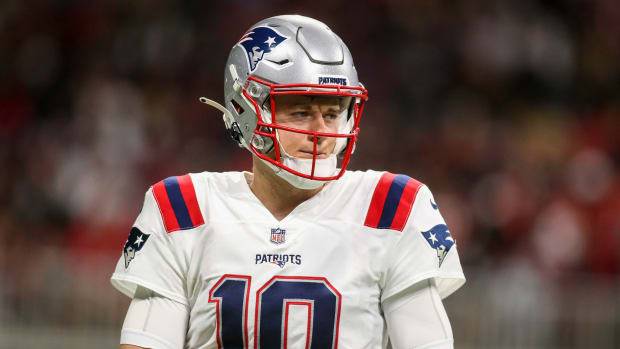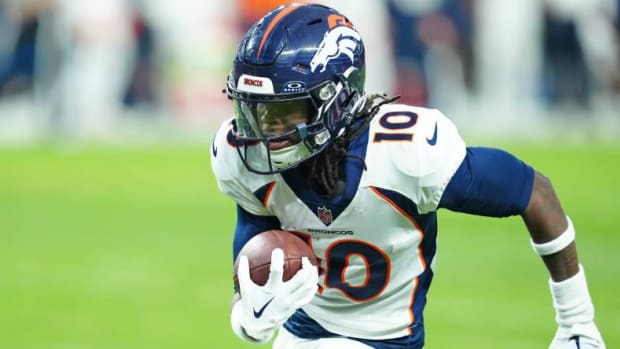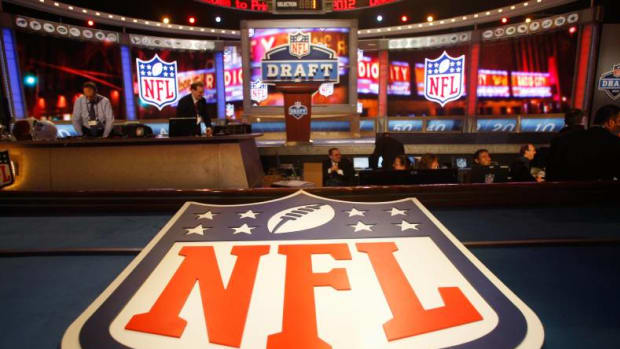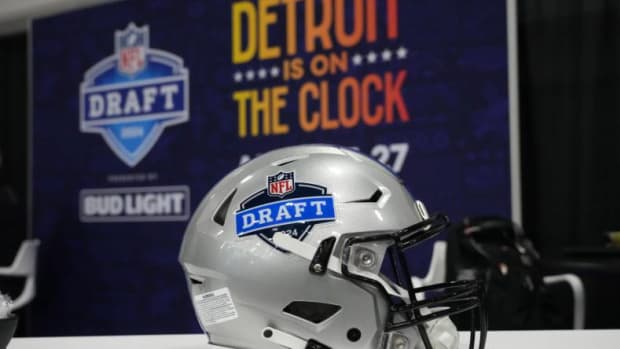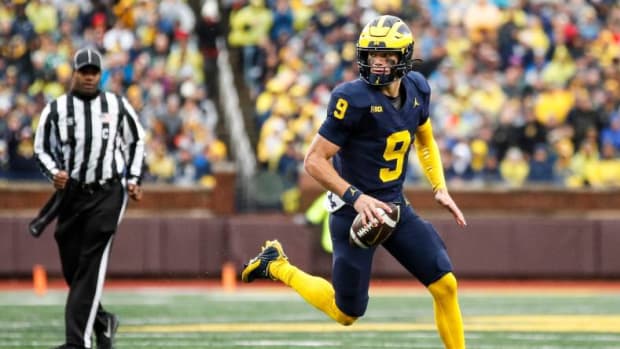2023 NFL Draft: The Chicago Bears’ Options with the No. 1 Overall Pick
With each passing week, the 2023 NFL Draft order comes more clearly into focus. Before the start of the NFL Playoffs, however, the Chicago Bears locked up the No. 1 overall pick by virtue of having the worst win-loss record in the league. This article walks through how the Bears might think about using that pick.
Few assets are as valuable to NFL general managers as the No. 1 overall pick in the NFL Draft. The first pick in the 2023 NFL Draft is no different. Going into the 2022-23 NFL offseason, the Bears are sitting on a goldmine with the top selection.
Chicago's 2022 record was 3-14. The team struggled down the stretch, dropping its last ten games in a row. But the season had a few bright spots, including the development of young quarterback Justin Fields—whom the team drafted in the first round of the 2021 NFL Draft. In his second year in the league, Fields amassed 2,242 passing yards, a 17:11 touchdown-to-interception ratio, and 1,143 yards rushing and eight rushing touchdowns.
Although the Bears lost significantly more games than they won, Fields looked like the kind of quarterback the team could build around. That hasn't stopped some from asking whether the Bears should spend the top pick on a passer (in all fairness, a natural question for any team with the first overall selection).
The Bears have three options when it comes to the first pick. The first is to draft a quarterback. The second is to draft a non-quarterback, and the third is to trade the selection. This article analyzes each option in turn.
Drafting a Quarterback at No. 1
As good as Justin Fields was in 2022, the Bears might decide that they should make a change at quarterback. This option has some merits—in particular, the Bears would get two more years of team control (at an invariably higher salary, to be sure) of any quarterback they pick at No. 1. Literature supports the idea that having a quarterback on a rookie contract is quite helpful in maximizing a team's Super Bowl chances.
Drafting a quarterback at No. 1 probably involves also trading away Fields. And Fields could almost certainly command a hefty haul on the open market. Plenty of NFL teams would gladly trade a boatload of assets for a young, rising star quarterback on a rookie contract like Fields.
In just the last few years: Amid a slew of sexual assault allegations against him, Deshaun Watson commanded three first-round picks and a few mid-round picks from the Cleveland Browns. The Denver Broncos traded two first-rounders, two second-rounders, and some players for Russell Wilson. And the Los Angeles Rams moved two first-rounders, a third-rounder, and starting quarterback Jared Goff to the Detroit Lions for Matthew Stafford—with whom the Rams would go on to win the Super Bowl.
Three first-round picks would probably be the starting bid for Fields, with the Bears likely to be able to extract multiple middle-round selections, and possibly some players as well, from interested suitors. The trade would instantly be one of the most significant blockbusters in NFL history.
At that point, the judgment would be comparative. The initial question is not whether the Bears should draft a quarterback in the abstract. The initial question is whether any quarterback in the 2023 NFL Draft class is an obvious upgrade over Fields. The follow-up question is whether the combination of Fields and whatever the Bears could get out of the No. 1 pick (whether by using it or trading it) is better than the combination of what the Bears could get in a trade for Fields and the quarterback on whom the team would spend the first overall pick.
So, to make the trade, the Bears would want to determine that:
[Assets from Fields Trade + Best QB in the 2023 NFL Draft Class] >
[Justin Fields + Value of No. 1 Overall Pick]
This proposition is dubious. The quarterbacks legitimately in play at No. 1 are Ohio State's C.J. Stroud (who replaced Fields in Columbus), Alabama's Bryce Young, and Kentucky's Will Levis. Some draft analysts like Florida's Anthony Richardson; others are fans of Tennessee's Hendon Hooker. But if Chicago is going quarterback at No. 1, the likelihood is that the team is choosing between Stroud, Young, and Levis.
Stroud is probably the safest bet of the three quarterbacks, while Young has the most interesting skill set and Levis has the highest upside. None of the three, however, represents enough of a surefire improvement over Fields to justify a trade. (Things might be different if this was next year's class—both USC's Caleb Williams and UNC's Drake Maye appear to be burgeoning generational talents at quarterback.)
Even if the Bears could land three first-round picks and a set of other assets for Fields, the package would not change the fact that Chicago would likely be downgrading at quarterback, representing a step back at what many still believe is the most important position on the field.
For these reasons, the Bears should probably refrain from trading away Fields and drafting a quarterback at No. 1. Nevertheless, the option is worth exploring.
Drafting a Non-Quarterback at No. 1
If the Bears decide to roll with Fields, as they likely should, the board opens up a bit at No. 1. The 2023 NFL Draft class features a set of top-flight prospects on both sides of the ball. Starting on defense, Alabama EDGE Will Anderson Jr. and Georgia defensive tackle Jalen Carter are the obvious players under consideration with the first pick. Texas Tech EDGE Tyree Wilson has a nonzero chance of destroying the NFL Scouting Combine and putting himself in play at No. 1 overall. And Clemson defensive linemen Myles Murphy (an EDGE rusher) and Bryan Bresee (a defensive tackle) are also in the Top 5 conversation.
Taking an offensive player is a bit trickier of an endeavor. None of the non-quarterback offensive players on the board are clearly No. 1-overall caliber prospects. Chicago could nab an offensive tackle like Georgia's Broderick Jones or Ohio State's Paris Johnson Jr., but either would be a bit of a reach. Another sleeper possibility is that Chicago takes a wide receiver—in particular, TCU's Quentin Johnston—at No. 1. One of the Bears' main issues this season was that Chicago had very few weapons around Fields. Johnston would come in as a true No. 1 receiver. He is a big-bodied target with impressive route-running skills, and he would instantly bolster Chicago's offense in a way that very few offseason acquisitions could do.
One need not look too far to see how adding a No. 1 receiver can change a team's fortunes. Justin Jefferson was a pivotal part of the Minnesota Vikings' playoff run, Stefon Diggs played a key role in the Buffalo Bills' playoff push, and A.J. Brown helped the Philadelphia Eagles leap to the top of the NFC. Other examples abound—Ja'Marr Chase on the Cincinnati Bengals, CeeDee Lamb on the Dallas Cowboys, and Tyreek Hill on the Miami Dolphins, to name a few.
Still, if the Bears keep No. 1, the pick is probably Anderson or Carter. Either would be a Day One starter on a Bears defense that desperately needs to get better up front. Carter might be a better scheme fit for the Bears, and in terms of the rest of the class, the Bears will find an easier time getting a starting-caliber EDGE rusher in the second round than they would with finding a good defensive tackle at that same point in the draft. Thus, keeping the first overall pick could allow the Bears to bring in a draftee who might end up being the best player on the defense as early as his rookie year. That possibility is nothing to disregard lightly.
Trading the Pick
Returning to the earlier discussion about quarterbacks, the 2023 NFL Draft boasts a few top-flight quarterbacks: Ohio State's Stroud, Alabama's Young, and Kentucky's Levis. The likelihood is that the market for the No. 1 overall pick is the set of teams interested in picking one of these three quarterbacks. (That said, a team might want to trade up to No. 1 for a player like Anderson or Carter, though that possibility is less likely.)
Consider some of the following past packages for top picks to draft quarterbacks (props to Josh Schrock at NBC Sports Chicago for putting together a version of the below, with a focus on No. 1 overall picks):
- In 1990, the Indianapolis Colts traded the following to the Atlanta Falcons for the No. 1 overall pick, with which they drafted quarterback Jeff George and a fourth-rounder:
- Offensive tackle Chris Hinton
- Hinton was an already established six-time Pro Bowler who played a few seasons as a solid tackle for the Falcons, including another Pro Bowl season in 1991 and an All-Pro season in 1993
- Wide receiver Andre Rison
- Rison was going into his second year (the Colts had picked him in the first round of the 1989 NFL Draft), and he played five spectacular years in Atlanta, making four Pro Bowls and earning an All-Pro nod in 1990 before moving on from the team in 1996
- A fifth-round pick in 1990
- A first-round pick in 1991
- In 1998, the San Diego Chargers traded the following to the Arizona Cardinals for the No. 2 overall pick, with which they drafted quarterback Ryan Leaf:
- The No. 3 overall pick in 1998
- A second-round pick in 1998
- A first-round pick in 1999
- In 2001, the Falcons traded the following to the Chargers for the No. 1 overall pick, with which they drafted quarterback Michael Vick:
- The No. 5 overall pick in 2001
- A third-round pick in 2001
- A second-round pick in 2002
- Wide receiver Tim Dwight
- Dwight was a decent wideout for the Falcons, who posted a couple of solid years for the Chargers amid a four-season stint with the team
- In 2004, the New York Giants traded the following to the Chargers for quarterback Eli Manning, whom the Chargers had just drafted with the No. 1 overall pick (Manning did not want to play for the Chargers):
- Quarterback Philip Rivers
- The Giants had just drafted Rivers with the No. 4 overall pick in the 2004 draft; Rivers went on to be one of the most decorated quarterbacks in Chargers history, earning selection to the Pro Bowl eight times over a storied career
- A third-round pick in 2004
- A first-round pick in 2005
- A fifth-round pick in 2005
- In 2012, Washington traded the following to the Rams for the No. 2 overall pick, with which they drafted quarterback Robert Griffin III:
- The No. 6 pick in 2012
- A second-round pick in 2012
- A first-round pick in 2013
- A first-round pick in 2014
- In 2016, the Rams traded the following to the Tennessee Titans for the No. 1 overall pick, with which they drafted quarterback Jared Goff, and a 2016 fourth-rounder and sixth-rounder:
- The No. 15 pick in 2016
- Two second-round picks in 2016
- A third-round pick in 2016
- A first-round pick in 2017
- A third-round pick in 2017
- In 2016, the Philadelphia Eagles traded the following to the Cleveland Browns for the No. 2 overall pick, with which they drafted Carson Wentz, and a 2017 fourth-rounder:
- The No. 8 pick in 2016
- A third-round pick in 2016
- A fourth-round pick in 2016
- A first-round pick in 2017
- A second-round pick in 2018
- In 2017, the Bears traded the following to the San Francisco 49ers for the No. 2 overall pick, with which they drafted quarterback Mitchell Trubisky:
- The No. 3 pick in 2017
- A third-round pick in 2017
- A fourth-round pick in 2017
- A third-round pick in 2018
- In 2018, the New York Jets traded the following to the Colts for the No. 3 overall pick, with which they drafted quarterback Sam Darnold:
- The No. 6 overall pick in 2018
- Two second-round picks in 2018
- A second-round pick in 2019
- In 2021, the 49ers traded the following to the Miami Dolphins for the No. 3 overall pick, with which they drafted Trey Lance:
- The No. 12 overall pick in 2021
- A third-round pick in 2021
- A first-round pick in 2022
- A first-round pick in 2023
Looking at the recent history of trades for top selections to draft quarterbacks, the Bears' market for the No. 1 pick probably comprises the teams picking between No. 2 and 16 in this year's draft. The price tag, however, gets quite steep after pick No. 10—maybe a bit too steep. In trading up from No. 15 to No. 1 for Jared Goff in 2016, the Rams had to give up two first-rounders, two second-rounders, and two third-rounders. And the 49ers gave up three first-rounders (and a third-rounder) to move up from No. 12 to No. 3 for Trey Lance.
Overall, based on the recent trades discussed above, the likely asking price for the No. 1 overall pick will be:
- A 2023 first-round pick
- Another first-round pick (depending on how far down the board the 2023 first-round pick is)
- Some combination of:
- Another first-round pick
- A second-round pick or two
- A third-round pick or two
The most obvious of the teams in play for the No. 1 pick are the Houston Texans, Indianapolis Colts, Las Vegas Raiders, and Carolina Panthers. But a handful of other teams could conceivably determine that trading for a young, superstar quarterback is a worthwhile endeavor, including the Seattle Seahawks, Detroit Lions, Atlanta Falcons, Tennessee Titans, and New York Jets.
Assuming the Bears make the trade, they would still be able to take one of the top prospects in the draft, add another prospect or two on Day Two of the 2023 NFL Draft, and arm themselves with some future first-rounders. Imagine the following additions in a hypothetical trade with the Raiders to go along with the selection of an EDGE rusher (say, Ohio State's Zach Harrison) or linebacker (maybe Iowa's Jack Campbell) with the second-round pick that Chicago acquired from Baltimore for Roquan Smith:
- No. 7 pick (from Las Vegas): Defensive tackle Bryan Bresee, Clemson
- 2023 second-round pick (from Las Vegas): Wide receiver Josh Downs, UNC
- 2024 first-round pick (from Las Vegas)
- 2024 second-round pick (from Las Vegas)
This package would allow Chicago to pick up a top defensive tackle prospect, add a speedy receiver who could give Fields a true deep threat, and improve the Bears' outlook for the 2024 NFL Draft—potentially giving them the assets necessary to trade up for Williams or Maye if Fields regresses in year Three. The Bears would look much better going into the 2023 season if the draft goes this way.
A trade may end up being the best option for the Bears. The team could almost certainly get one of the players that they would otherwise consider at No. 1 overall if they trade down within the Top 5 (which a trade with any of the Texans, Colts, or Seahawks would likely entail). Even a trade down within the Top 10 would still yield a tremendous prospect.
Whether any of Stroud, Young, or Levis is worth the likely haul it would take to acquire the No. 1 overall pick is a question for another article. Stroud probably is—he would stand a decent chance of taking the Seahawks (or the Raiders, who have some amazing offensive weaponry) to the playoffs in 2023 if the team decided to move on from Geno Smith. He could be the centerpiece of a rebuild in either Houston or Indianapolis. He could also benefit from sitting behind a player like Jared Goff for a year in Detroit as the Lions work to figure out what comes next for their up-and-coming franchise. Stroud has almost as good of an arm as Levis does, but he possesses better instincts and has fewer mechanical issues to clean up.
For the Bears, trading the No. 1 pick could yield the sort of package necessary to jumpstart the team's rebuild around Fields.










